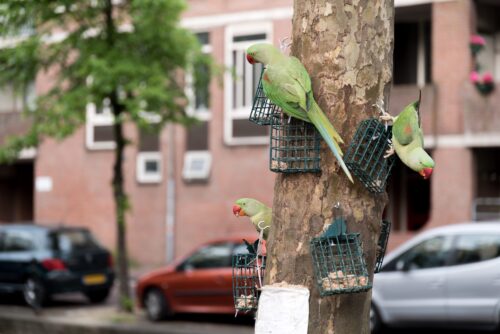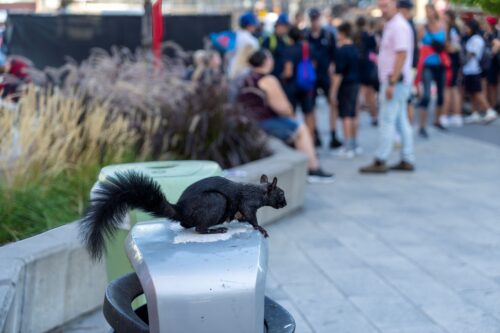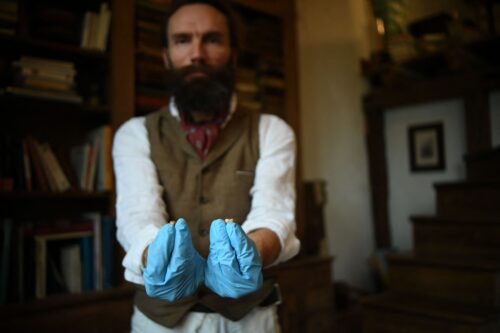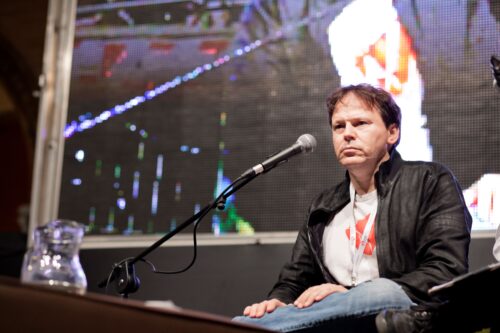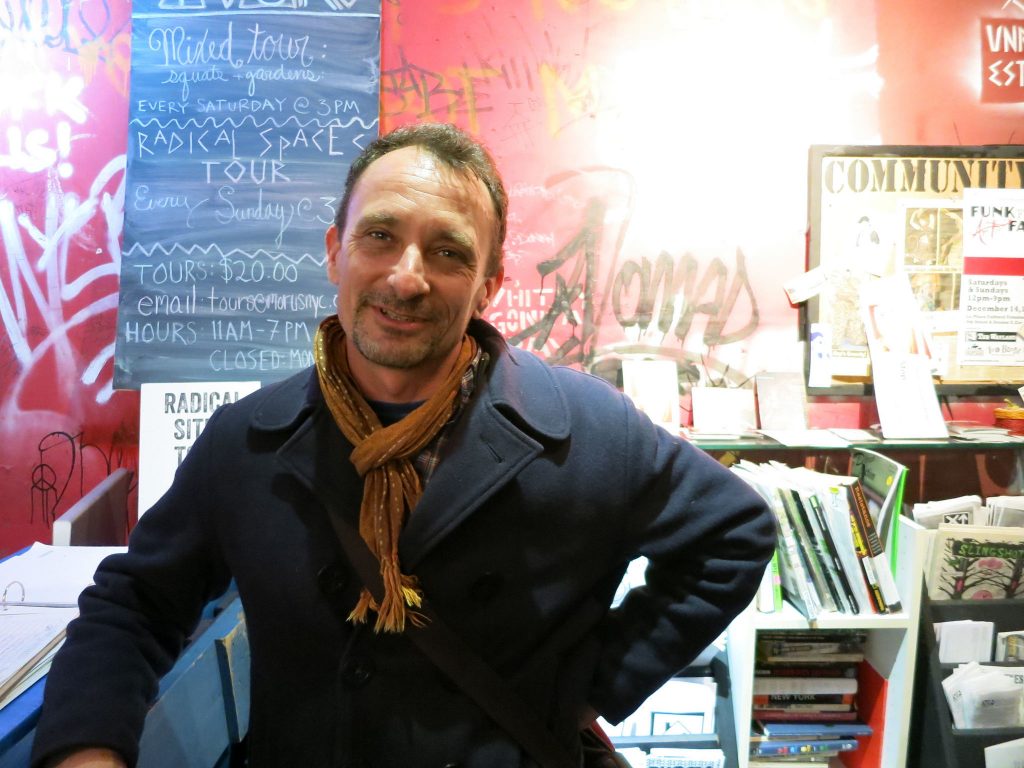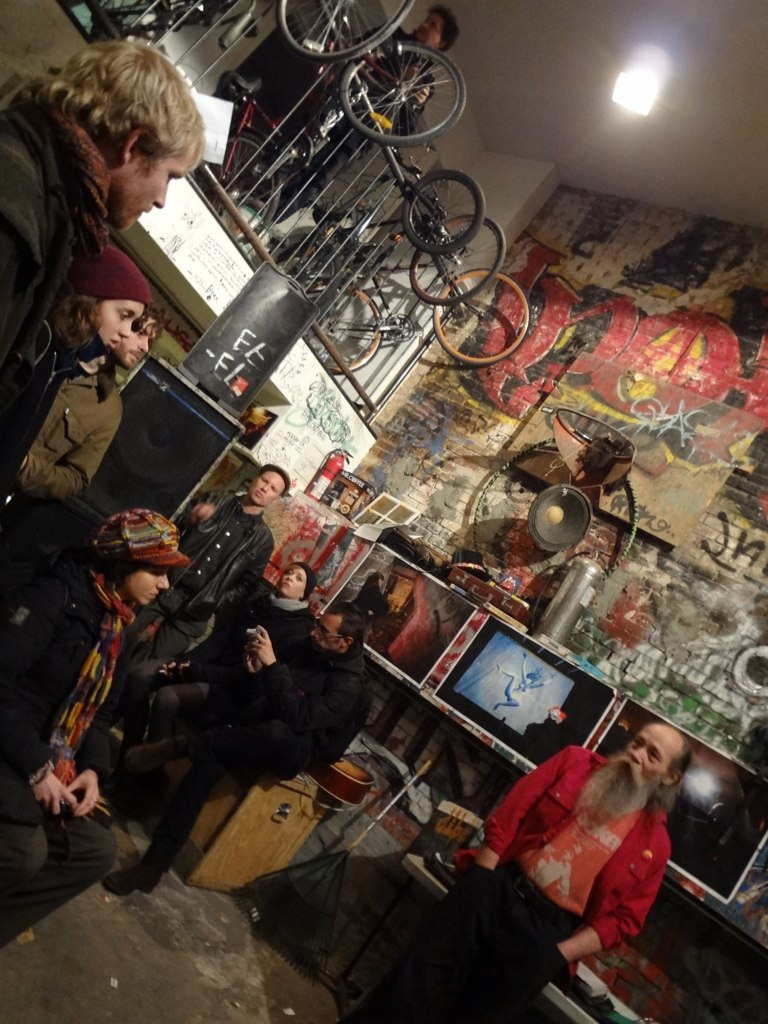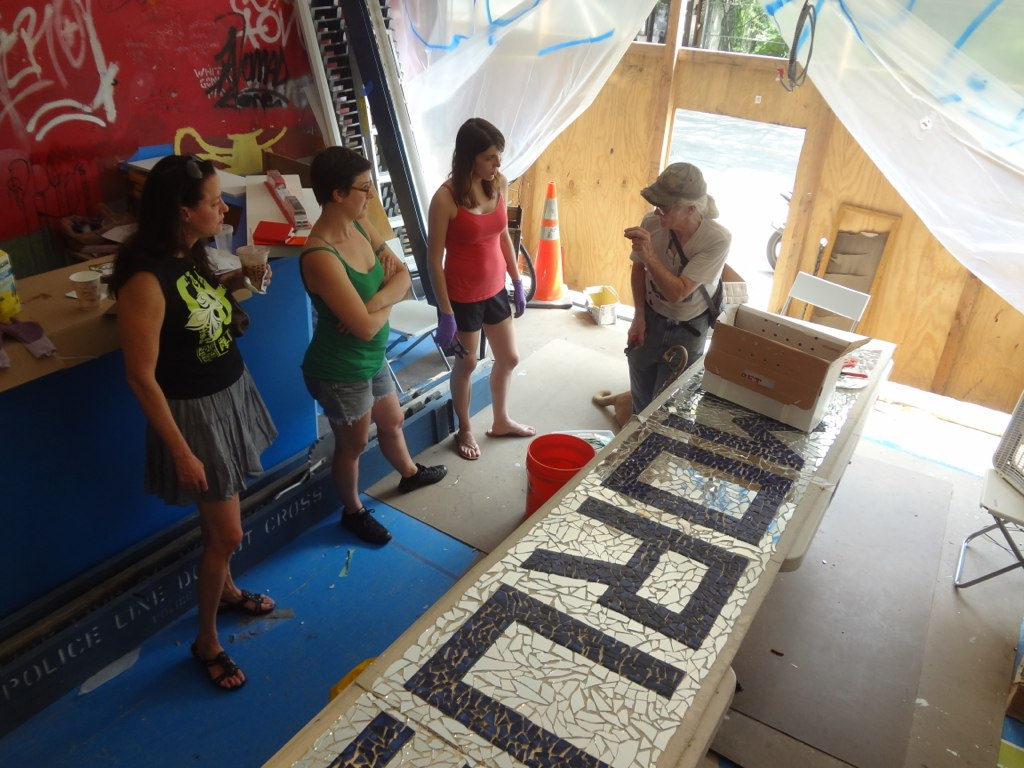The Transformation of One of New York City’s Most Famous Squats
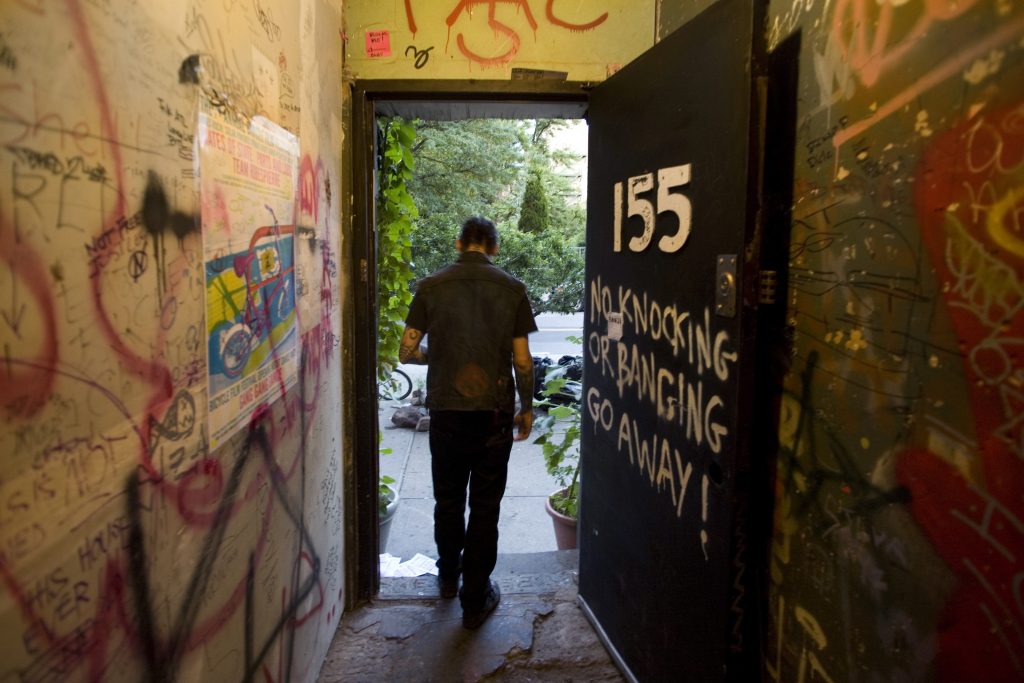
I was surprised when I first met the man nicknamed Bald Mike. I was told I should approach him with caution: He had a temper and could be paranoid. And so I did a double take when I was introduced to a tidy, older, white-haired man walking a sweet hound dog toward the basement of C-Squat, a famous house I was studying as an anthropologist in New York City from 2010 onward. I was expecting someone dirty, who maybe had face tattoos, a pit bull, and a nasty attitude. But Mike seemed truly happy to meet me, perhaps in part because he wanted my help with his project.
In the world of squatters, it matters a lot who “opens” a building. There is a whole lingo around it: In Amsterdam they call it “cracking” a new squat, and squatters are called “krakers.” Taking the first audacious step to break into an abandoned building and claim it provides not only a much-needed roof over one’s head—it gives a person bragging rights. In the complex networks of family-like social ties that bind squatters together, the person who opens a building is like a founding ancestor. People who open squats can become mythic figures.
Mike was one of them—and not just for any squat. Residents of C-Squat are known worldwide as being among the hardiest of Lower East Side squatters. After he opened the place in 1989, C-Squat became a punk rock mecca: an incubator of influential anarcho-punk bands and home to truly legendary and wild basement punk shows.
Mike lived there through the early years of C-Squat but left in protest shortly after 2002 when the house members, along with those of 10 other Lower East Side squats, decided to undertake the lengthy and turbulent task of bringing the building up to code and making the residents legal homeowners. He said he wanted no part of this massive change to the building’s culture. But by 2010 Mike was back, and he was trying to preserve some of the squat’s history before it was lost for good.
The five-story tenement at 155 Avenue C is one of the most famous squats in an area with a rich history. In the city’s Lower East Side, just a few miles from Wall Street, squatters claimed and held city-owned abandoned tenement buildings in the 1980s and ’90s in a city where private property rights are tightly enforced. The structures they made into homes were barely fit to be called buildings. Built before the start of the 20th century, run down by over a century of heavy use, neglected by landlords, then burned, abandoned, stripped by scavengers, used by junkies, and damaged by a city government trying to discourage squatters, they were more like shells. New York City squatters had to create electrical and plumbing systems from scratch, replace giant structural beams, and rebuild brick walls.
When C-Squat was opened in the summer of 1989, there were no stairs and no landings; apartment doorways faced into a void, with only a network of ladders to connect them. “It was like a stage set,” remembers Popeye, a longtime C-Squat resident who still lives there today. “There was much drama of getting dogs up and down, and drunks up and down.”
C-Squat’s basement underwent a transformation from a near disaster a few years into the squatters’ occupation. “That big open space [in the back] was not planned,” recalls Tauno Biltsted, another early C-Squat resident. “Essentially, the whole ground floor back of the building, those joists, collapsed. They just collapsed one night. And I was in the building when it happened. … And it sounded like, it was like a ship or something. … It was like creaking, … and then it just, like, the whole freaking thing, … it just all collapsed.”
Rather than rebuild it, residents decided to work with an architect ally to brace the walls and ceiling, and keep the open area as a two-story event space. At first, it got kind of gross, residents remember: With no glass in the windows on the back wall, the space filled up with water when it rained and was a catchall for human and animal waste. “Every dog turd, because the dogs would shit down there, or cat turd, or human turd on the basement floor one summer blossomed into this amazing fungus … it sprouted, like, fur, like Gremlins,” Popeye says. “Iridescently, pearlescent, blue-gray silver fur. … We should have taken a sample to the Smithsonian or something.” Hepatitis started to spread through the filthy water, he recalls. “The place smelled awful,” he adds.
But it was also a phenomenon. The walls were layered with graffiti. Residents’ bikes dangled from every available surface. Later they built a legendary indoor skate ramp. The basement was where the famous punk shows were held. There was a balcony from which the timid could watch the swirling pit and onlookers could throw beer onto the revelers. The basement was also where travelers stayed: young punks—often runaways—in some cases with drug problems, who circled the country hopping trains, finding food in dumpsters, and weaving the networks that kept punk rock culture alive.
So it was a big change when, in 2002, C-Squat residents agreed to join a loose network of Lower East Side squats in a deal they had negotiated with the city to go legal. Each building would be sold to a nonprofit intermediary for US$1. The nonprofit would take out loans on the squatters’ behalf to renovate the buildings and bring them up to code. (Such moves are aimed at preventing horrible tragedies like the Oakland warehouse fire in December 2016 that started in an unpermitted artists’ collective, but they also present huge logistical and financial challenges.) Once each building was legally inhabitable, it would be transferred to its residents, along with the accumulated renovation debt. The squats would become low-income, limited equity co-ops—and the squatters, indebted homeowners.
Somehow, everyone involved imagined that this would be relatively easy. It wasn’t.
There were countless complications, hang-ups, and disputes. In 2007, C-Squat closed their basement to the free flow of travelers: With the nonprofit and the bank scrutinizing their governance, police noticing drug activity in the building, and building inspectors poking into every corner, they could no longer accommodate a large, transient population. This outraged many and brought on accusations that the squat had “sold out.” The residents of C-Squat’s 16 apartments, who made decisions using a mix of consensus and voting, were torn between their tradition of welcoming anyone who needed a place to crash and the pressures of impending homeownership.
When Mike returned in 2010, he argued that he deserved one of C-Squat’s much-coveted apartments since he had opened the building. There was some dispute about this. Another old-school squatter, a fire-dancing performance artist who went by the name Vlad, claimed that he’d been the one to first cut the lock and enter C-Squat. Horrified at the disgusting and dilapidated state of the building, he’d fled in search of someplace better, he said. Before he left, he put on his own lock. And then, in his version of the story, he gave the key to Bald Mike. So perhaps Bald Mike did something less adventurous than cracking the building: Maybe he simply turned the key and walked in.
Either way, most residents accepted that Bald Mike deserved recognition. The important thing was that, unlike Vlad, he’d stayed. He had worked incredibly hard, rallied others, and anchored the growing community through the difficult early years of hauling rubble, peeing in buckets, being half-frozen in winter, and hauling more rubble. Some C-Squat residents thought that this entitled him to a permanent, unrestricted right to a home in the building. Others argued that, since he did not intend to pay for his space, as others would have to do once the squat legalized, the collective could not afford to house him. As a compromise, they gave him a private, windowless space in the famous basement, where he shared a small room with the newly installed electrical panels and the boiler.
I first came to C-Squat in the spring of 2010, wondering how this group of longtime squatters was handling the transition to collective homeownership. After I was introduced to Bald Mike in 2012, it took a few weeks of knocking on his basement door before I finally caught him at home.
When Mike let me in, I found his space clean, quiet, and dry. He had a cot, with his hound dog Stella’s smaller cot beside it, and his stuff was piled up in boxes around them. By sitting at the foot of the cot, Mike could access his workstation: a scanner hooked up to a dirty white MacBook with tape over the built-in video camera. Piled high in all directions were boxes of negatives. He had not only participated in the earliest days of C-Squat’s occupation, he had documented them. His large-format negatives managed to capture the beauty of the raw spaces and of the era’s young people without romanticizing them. The images were extraordinary, magical, and gritty, and we looked at them together for hours.
Mike knew his time in the basement was limited. The residents of C-Squat had made a hard decision to rent the storefront space in order to earn rent and keep their monthly payments affordable once they finally became a co-op. Giving up the storefront meant losing what had been C-Squat’s living room—and evicting Bald Mike from the basement below.
The decision came after much debate about what to do with the space. If they rented it at market rates, which were high on bustling and heavily gentrified Avenue C, they could cut their payments significantly. Residents had joked uncomfortably about what it would look like to have a Starbucks in the storefront of C-Squat. Some wanted an art gallery; others lobbied for a needle exchange. They finally decided to go with a nonprofit tenant who fit with their shared values and to charge them below-market rent. The Museum of Reclaimed Urban Space (MoRUS) was just getting going and seemed like a perfect fit. Founded by a former squatter from a building a few blocks south on Avenue C, the museum would feature squat history, among other exhibits. At C-Squat, the museum could build out the space to suit its needs, and it planned to preserve one of the room’s graffiti walls.
While waiting to be evicted, another basement dweller passed the time writing an Onion-style satirical newspaper article with the headline: “Last Squatters Kicked Out of C-Squat to Make Way for Squatting Museum.” The squat was in an ironic dilemma.
Mike was rushing to scan his negatives—a laborious process that could conceivably take months—before he was kicked out. He feared that his belongings might be scattered to the winds and that he might die when he was evicted. He wanted my help. We talked about archives, file management systems, digital preservation, and enlisting an intern. He even considered inviting me to interview him, so his stories could be included alongside those of other C-Squat residents whose oral histories I was recording.
While we were talking, soapy water started pouring down the front wall of the building; soon after, volunteers from the new museum knocked on the door. They had been washing the floors and came down to check and see if the water was draining into the basement, which it was. The volunteers had never been in his room before and were pretty excited when they saw Mike’s pictures. But these images were one of his few valuable possessions, and he was not keen to share them, especially with the museum to which he was losing his home. Once they had confirmed where their soapy water was disappearing to (and caught a glimpse of the pictures), the volunteers left me and Mike alone. All of their subsequent attempts to get him to share his images failed.
Before the legalization process began, C-Squat residents had considered themselves to be like a family. They had not chosen each other, but they stuck together through thick and thin. Many were runaways and/or were formerly homeless, and they turned to each other for food, friendship, and shelter. Their tasks required teamwork, from rebuilding the stairwell to controlling access to the building.
The usual notion of American kinship suggests that families are built through blood and marriage. But sustained eating, working, and living together can also produce kinship ties. Many longtime C-Squat residents, and residents of other buildings, told me that the squats were like families. And all squatters called their collectives “the house.”
“House societies,” a concept first described by the famous anthropologist Claude Lévi-Strauss, have been found everywhere from medieval Europe to the Pacific Northwest, specifically with the Kwakwaka’wakw. In house societies, people are tied together by their connection to shared property—usually including an actual large house—and communal history, often including a lineage of ancestors. In order to survive as a group, they must protect the property and the history that defines them. As C-Squat’s legal status shifted, this is what the squatters, a house society of sorts, were struggling to do.
“You wouldn’t necessarily kick your brother out of the house because he wasn’t paying you rent,” says Erin Williams, who came of age in the building. “[But] at a certain point, you have a bank loan to pay, and if you don’t pay it, then the bank doesn’t fucking care that these are your friends, they just want their money. … Too bad, so sad, you’ve lost the building. … I don’t want to lose my home.”
When MoRUS finally claimed the basement space in 2012, Mike temporarily moved into a corner of the balcony, and then, just before the museum opened, he disappeared, taking all of his photographs with him. He had never sat for an oral history with me. No one I’ve talked to has heard from him. No one seems to know where he went or what happened to his records.
By 2015, C-Squat finally assembled a collection of rent-paying members and passed the final hurdle to become a co-op. But they did it without Bald Mike and without many of the people captured in Mike’s photos who had opened the building. Their tangible property—the house that sheltered them—was intact. But some of the intangible property that bound them together—their history—was gone.
The building will probably survive as a low-income co-op for decades to come. What is less clear is whether it will survive as C-Squat: a “house” and family.
This essay won the 2016 SAPIENS-Allegra Margaret Mead writing competition.





